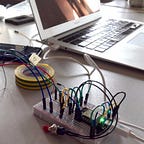Part 2: Research
We all have limits to our abilities — physical, social, emotional and cognitive. How can we design to embrace these universal things that make us human, but also create solutions that are highly adaptive to an individual person?
We as designers can help to remove obstacles, enabling people to participate in society no matter their individual challenges. Let’s imagine a future that puts human empathy at their design core!
This is a work-in-progress documentation of a design project on the topic of inclusion and technology. We as a group of design students are working on design for the blind as part of a collaboration between Microsoft Research and University of Applied Sciences Potsdam. More background information at the bottom.
A good read
Eyeglasses have been transformed from medical necessity to fashion accessory. Why shouldn’t design sensibilities also be applied to hearing aids, prosthetic limbs, and communication aids? —taken from the blurb.
“Design meets disability” by Graham Pullin is a good read on the tension between fashion and discretion, simple vs. universal, provocative vs. sensitive and many more. Being rather on the theoretical side, it broadens and deepens thinking about inclusive design at the same time.
A scenario to focus on
Inclusion, disability and design make up for a huge variety. Therefore we had to narrow down to a manageable spectrum of scenarios before we deepen our research. We feel vision impairments make up for a promising topic, with “shopping for groceries” as our primary scenario.
Taxonomy of a grocery store
How do supermarkets “work”? What are the underlying principles in terms of layout, hierarchy, organisation and product placement? How do customers find their way? How do they know where to find which item?
In order to be able to redesign grocery shopping for the visually impaired, we have to understand a supermarket’s taxonomy. First, everyone of us tried to draw his primary supermarket’s layout from memory.
Interestingly enough, supermarkets more or less rely on the same principles, based on scientific research and aiming to seduce the customer to buy as much as possible, as we found out studying a number of papers. These are our key findings:
– Customers usually have to run around a supermarket counterclockwise, tricking the brain into attentiveness and therefore perceiving more products
– Produce is placed close to the entrance to make you slow down
– Everyday products such as cheese or eggs are far away from each other to make you cover a bigger distance, thus seducing to buy additional things
– Products belonging to each other are arranged close to each other so that the customer thinks of coffee as well when buying jam
– Shelves are set up angular. This way, the customer sees a higher number of products at a time
Market research
Aside from a general supermarket’s taxonomy: Are there already solutions on the market addressing the problem of grocery shopping for the visually impaired and blind?
Here’s a brief overview of what we’ve found.
White cane
A blindman’s stick is the commonly used tool to orientate.
iPhone
The iPhone is widely popular in the blind community for it’s superior accessibility, for instance VoiceOver and text to speech.
Be My Eyes App
Be My Eyes is an innovative service we really like. It makes life easier for the blind, by connecting them with sighted helpers through a smartphone app. This allows the blind to handle big and small tasks, while sighted get the joy of helping someone else in a easy and informal way.
Colorsay App
Scan your environment with your smartphone’s camera and the Colorsay app will tell you which color you are pointing at.
TapTapSee App
TapTapSee uses artificial intelligence to identify what is in front of your smartphone camera. It also reads out what is written on the label of e.g. your bottle of milk!
The Reading Finger
The reader is a combination of a finger device and Bluetooth Headset, where the finger-pointer scans products for barcodes and relays the product information to earpiece as audio instructions. Info like product description, price, ingredients, nutrition etc. is easily accessible.
While we welcome that the device is handy and unobtrusive, we believe it might be hard for a blind person to actually find the barcode on the label before being able to scan it.
Appendix
What is this about?
Inclusion is a relevant and up-to-date topic widely debated recently. The WHO revised their definition of disability, shifting it from a fixed attribution to a context sensitive consideration. We as designers can help to remove obstacles, enabling people to participate in society no matter their individual challenges. A human centered design approach with deep research and observation, rapid prototyping and cheaper yet more powerful technology can make quite an impact.
Each year, Microsoft Research sponsors a semester-long class at leading design schools. This year’s design challenge is about Inclusive Design & Technologies. Let’s imagine a future of adaptive systems that puts human empathy at their design core.
We as students from the design department of University of Applied Sciences are taking part in this global design event. The leading teams will be presenting their ideas at Microsoft Design Expo 2015 in Redmond, USA.
The designer behind the project
This is a project by Philipp Steinacher, Dominic Rödel, Laurids Düllmannand Henrik Hagedorn. We study interface design at the University of Applied Sciences Potsdam.
Read more
The website of Microsoft Research Design Expo 2015 provides in-depth information on the overall project.
